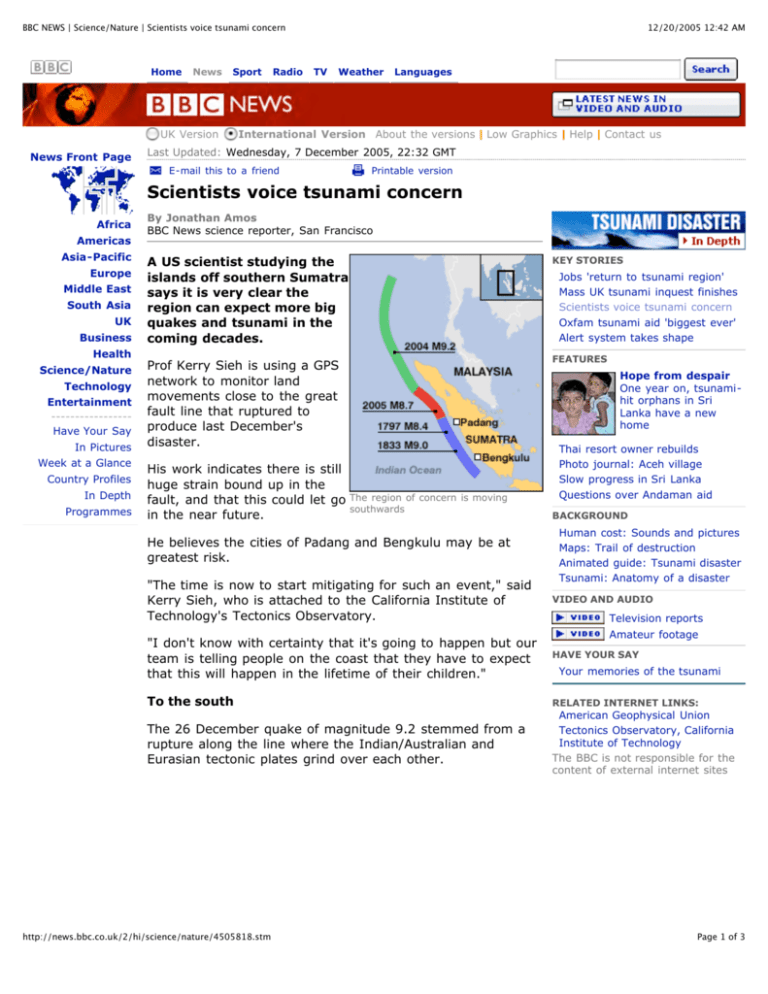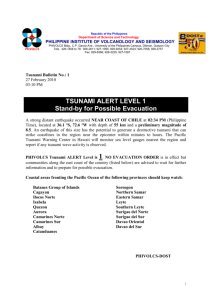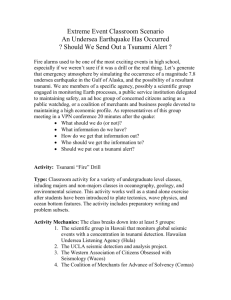Scientists voice tsunami concern
advertisement

BBC NEWS | Science/Nature | Scientists voice tsunami concern Home News Sport UK Version News Front Page Radio 12/20/2005 12:42 AM TV Weather Languages International Version About the versions | Low Graphics | Help | Contact us Last Updated: Wednesday, 7 December 2005, 22:32 GMT E-mail this to a friend Printable version Scientists voice tsunami concern Africa Americas Asia-Pacific Europe Middle East South Asia UK Business Health Science/Nature Technology Entertainment ----------------Have Your Say In Pictures Week at a Glance Country Profiles In Depth Programmes By Jonathan Amos BBC News science reporter, San Francisco A US scientist studying the islands off southern Sumatra says it is very clear the region can expect more big quakes and tsunami in the coming decades. KEY STORIES Prof Kerry Sieh is using a GPS network to monitor land movements close to the great fault line that ruptured to produce last December's disaster. FEATURES His work indicates there is still huge strain bound up in the fault, and that this could let go in the near future. Jobs 'return to tsunami region' Mass UK tsunami inquest finishes Scientists voice tsunami concern Oxfam tsunami aid 'biggest ever' Alert system takes shape Hope from despair One year on, tsunamihit orphans in Sri Lanka have a new home The region of concern is moving southwards He believes the cities of Padang and Bengkulu may be at greatest risk. "The time is now to start mitigating for such an event," said Kerry Sieh, who is attached to the California Institute of Technology's Tectonics Observatory. Thai resort owner rebuilds Photo journal: Aceh village Slow progress in Sri Lanka Questions over Andaman aid BACKGROUND Human cost: Sounds and pictures Maps: Trail of destruction Animated guide: Tsunami disaster Tsunami: Anatomy of a disaster VIDEO AND AUDIO Television reports Amateur footage "I don't know with certainty that it's going to happen but our team is telling people on the coast that they have to expect that this will happen in the lifetime of their children." HAVE YOUR SAY To the south RELATED INTERNET LINKS: The 26 December quake of magnitude 9.2 stemmed from a rupture along the line where the Indian/Australian and Eurasian tectonic plates grind over each other. http://news.bbc.co.uk/2/hi/science/nature/4505818.stm Your memories of the tsunami American Geophysical Union Tectonics Observatory, California Institute of Technology The BBC is not responsible for the content of external internet sites Page 1 of 3 BBC NEWS | Science/Nature | Scientists voice tsunami concern 12/20/2005 12:42 AM The associated tsunami wrought destruction throughout the Bay of Bengal, from Northern Sumatra to Thailand, Sri Lanka, and India. It was followed by a magnitude 8.7 in March - with the rupture occurring further south along the plate boundary. TOP SCIENCE/NATURE STORIES NOW Beagle 2 probe 'spotted' on Mars Trade can 'export' CO2 emissions Europe fish quota battle to begin Environmental prize for UN chief | What is RSS? Coastal trees are being submerged as the strain accumulates Prof Sieh, speaking here at the American Geophysical Union Fall Meeting, says the concern of scientists is now focused on events further south still, to a region known as the Mentawai islands patch. This zone has experienced giant earthquakes about every two centuries, and is nearing the end of its earthquake cycle. Coral rise Prof Sieh says the strain building up in the region is evident from the behaviour of island coastlines - some are becoming submerged. It is in the nature of tectonic plates that they do not glide smoothly past each other, as one dives under the other. In fact, the plates move in "stick-slip" fashion, which means land at the leading edge of the overriding plate is pulled down briefly before suddenly slipping back up, generating a large earthquake. Surveys along northern Sumatra following the 26 After a quake, land that had been December and 28 March events pulled down will pop back up have revealed coral reefs that have come out of the water as land has thrust back up. "When you look further to the south, the groves of trees and other coastal features are still sitting out in the water; they have not yet risen. So, we know the strain is still accumulating; our GPS network is telling us it is still accumulating," Prof Sieh explained. "Our concern is that the next thing to happen will be ruptures." Wave model Prof Sieh says historical and coral records show the Mentawai islands patch experiences magnitude 8-plus quakes on a roughly 200-year cycle, and are accompanied by large tsunami. "It appears that these giant earthquakes either occur singly http://news.bbc.co.uk/2/hi/science/nature/4505818.stm Page 2 of 3 BBC NEWS | Science/Nature | Scientists voice tsunami concern 12/20/2005 12:42 AM or in couplets: singly in the 1300s and late 1500s, and as a couplet in the late 18th Century and early 19th Century; and the average time between those three sets is about 240 years." Prof Stephan Grilli, from the University of Rhode Island, has modelled the tsunami that would result in the area from a magnitude 9.2 quake, the same as 26 December. "Our prediction for Padang and Bengkulu further south would be up to 10m waves hitting the The modelling predicts up cities," he told the AGU waves hitting the coast meeting. to 10m Both Padang and Bengkulu are bigger cities than Banda Aceh which was destroyed in the 26 December tsunami. Like Banda Aceh, Padang is very low-lying. E-mail this to a friend Printable version LINKS TO MORE SCIENCE/NATURE STORIES Select News Alerts E-mail services Mobiles/PDAs Back to top Help Privacy and Cookies Policy http://news.bbc.co.uk/2/hi/science/nature/4505818.stm News sources About the BBC Contact us Page 3 of 3






